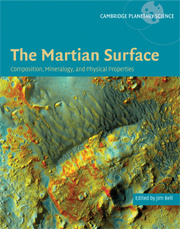The Martian Surface Composition, Mineralogy and Physical Properties Cambridge Planetary Science Series
Langue : Anglais
Coordonnateur : Bell Jim

A fresh look at the latest Mars discoveries for researchers and students in planetary science, astronomy, and space exploration.
Phenomenal new observations from Earth-based telescopes and Mars-based orbiters, landers, and rovers have dramatically advanced our understanding of the past environments on Mars. These include the first global-scale infrared and reflectance spectroscopic maps of the surface, leading to the discovery of key minerals indicative of specific past climate conditions; the discovery of large reservoirs of subsurface water ice; and the detailed in situ roving investigations of three new landing sites. This an important, new overview of the compositional and mineralogic properties of Mars since the last major study published in 1992. An exciting resource for all researchers and students in planetary science, astronomy, space exploration, planetary geology, and planetary geochemistry where specialized terms are explained to be easily understood by all who are just entering the field.
Dedication; Acknowledgements; Foreword; Part I. Introduction and Historical Perspective: 1. Exploration of the Martian surface: 1992–2007; 2. Historical context: the pre-MGS view of Mars' surface composition; Part II. Elemental Composition: Orbital and In Situ Surface Measurements: Part II. A. Results and Interpretations from New In Situ APXS Measurements: 3. Martian surface chemistry: APXS results from the Pathfinder landing site; 4. Mars exploration rovers – chemical composition by the APXS; Part II. B. Results and Interpretations from New Orbital Elemental Measurements: 5. Elemental abundances determined via the Mars Odyssey GRS; 6. Volatiles on Mars: scientific results from the Mars Odyssey Neutron Spectrometer; Part III. Mineralogy and Remote Sensing of Rocks, Soil, Dust, and Ices: Part III. A. Visible to Near-IR Telescopic and Orbital Measurements: 7. Mineralogy of the Martian surface from Mars Express OMEGA Observations; 8. Visible to near-IR multispectral orbital observations; Part III. B. Mid-IR and Magnetic Orbital Measurements: 9. Global mineralogy mapped from the Mars Global Surveyor Thermal Emission Spectrometer; 10. The compositional diversity and physical properties mapped from the Mars Odyssey Thermal Emission Imaging System; 11. Mars' crustal magnetization: a window into the past; Part III. C. Observations from Surface Landers/Rovers: 12. Multispectral imaging from Mars Pathfinder; 13. Mars Exploration Rover Pancam multispectral imaging of rocks, soil, and dust at Gusev Crater and Meridiani Planum ; 14. The mineralogy of Gusev Crater and Meridiani Planum derived from the Miniature Thermal Emission Spectrometers on the Spirit and Opportunity Rovers; 15. Iron mineralogy and aqueous alteration on Mars from the MER Mössbauer Spectrometers; 16. Magnetic properties results from surface landers and rovers; Part III. D: 17. Martian meteorites as crustal samples; Part IV. Physical Properties of Surface Materials: 18. The thermal inertia of the surface of Mars; 19. Physical properties of the Martian surface from spectrophotometric observations; 20. In-situ observations of the physical properties of the Martian surface; 21. Martian surface properties from joint analyses of orbital, Earth-based, and surface observations; Part V. Synthesis: 22. Implications of the observed primary lithologies; 23. Aqueous alteration on Mars; 24. The sedimentary rock cycle of Mars; 25. Implications for Martian polar processes; 26. Astrobiological implications of Mars surface composition and properties; Part VI: 27. Summary, upcoming missions, and new measurement needs; Acronyms; Index.
Jim Bell is an Associate Professor in the Department of Astronomy at Cornell University. He is the lead scientist for the Pancam color imaging system on the NASA Mars Exploration Rovers Spirit and Opportunity, and is also a member of the science teams of the NASA Mars Pathfinder, Near Earth Asteroid Rendezvous (NEAR), Mars 2001 Odyssey Orbiter, Mars 2005 Reconnaissance Orbiter, and 2009 Mars Science Laboratory rover mission teams. He has authored or co-authored more than 150 peer-reviewed scientific papers on Mars, is an editor for Icarus, and has an asteroid named after him (8146 Jimbell) by the International Astronomical Union.
Date de parution : 06-2008
Ouvrage de 652 p.
22.3x28.2 cm
Thème de The Martian Surface :
© 2024 LAVOISIER S.A.S.



